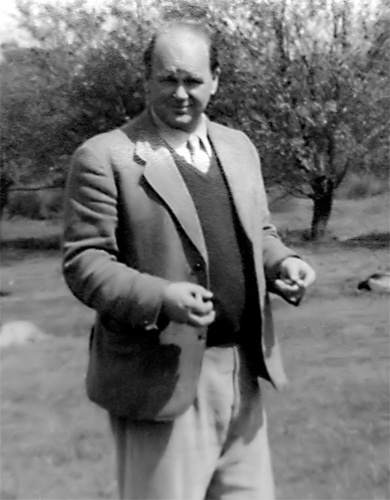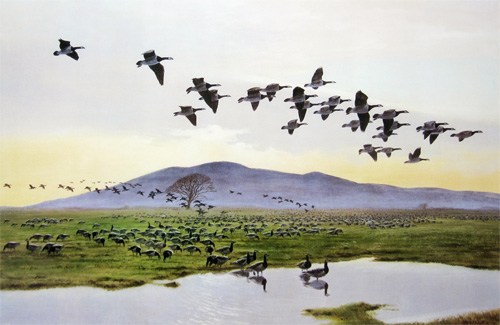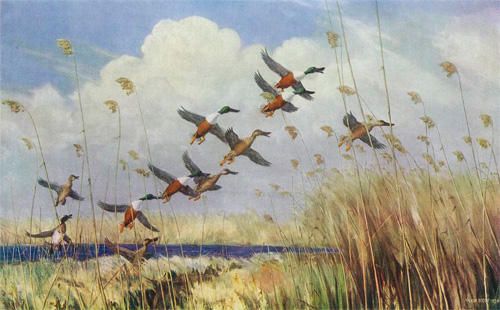An Appreciation of Sir Peter Scott, Artist
Sir Peter Markham Scott CH CBE DSC FRS (1909 - 1989) was the son of the Antarctic explorer Captain Robert Falcon Scott, who lost his life during an expedition to the South Pole in 1911.
Born in London, Peter Scott studied Natural Sciences and History of Art at Cambridge University. He became a naturalist, conservationist, ornithologist, artist, broadcaster and author, whose abiding passion was wildlife - and wildfowl and wild birds in particular.

Arpingstone, Public domain, via Wikimedia Commons
Scott was also a fine sailor, winning a bronze medal in the 1936 Olympics, a champion glider pilot, and an accomplished scuba diver. He served in the Royal Navy during World War 2, and was awarded the Distinguished Service Cross for bravery.
Described as the 'Father of Conservation', he led a campaign for endangered wildlife that captured the imagination of a generation, and inspired many to care about wildlife and the environment long before it became fashionable to do so.
He founded the Severn Wildfowl Trust (now the Wildfowl and Wetlands Trust or WWT) at Slimbridge in 1946, and co-founded the World Wide Fund for Nature (now the World Wildlife Fund or WWF).
The WWF's original panda logo was designed by Sir Peter in 1961, and the iconic emblem has been redrawn several times since then.
Peter Scott travelled the world observing natural history, and always kept a record in words and pictures of what he found. Out in the field, he sketched what he saw, using whatever medium that came to hand - pen, pencil, ball-point or felt-tip - adding colour with pastel or paint. His Travel Diaries of a Naturalist (3 volumes - first published 1983), include a large number of the sketches and paintings he produced on his travels.

He was the founder President of the Society of Wildlife Artists, and was highly regarded as a wildlife artist, having work accepted for exhibition at the Royal Academy. In the period before and after the Second World War, Peter Scott was widely considered to be the most popular artist in the United Kingdom.
Peter Scott used his artistic talents to fund his projects, and he is best known today for his paintings of flocks of geese and ducks in flight against a sunrise or sunset background.
He held his first one-man exhibition of paintings at London art dealers Ackermann and Son Ltd., in 1933, and Ackermann sold many of the artist's originals in the following years. Ackermann was Scott’s agent and representative for his artwork in Great Britain, while Falcon Arts Inc. represented him in the USA.
From 1936 to 1982, Ackermann published high quality reproduction colour prints of Sir Peter's work. Many of the originals are in major private and public collections, while his bird art prints remain highly collectable today.
His artworks were used to illustrate many books, such as The Snow Goose and Twentieth Century Wildlife Artists by Nicholas Hammond, while they also appeared on greetings cards, postcards, calendars, bone china, silverware, stamps, medals, coins, tableware, and other items - even cigarette cards.
So popular were Scott's ornithological paintings, that his work was soon imitated. In December 1957, Scott complained to The Medici Society that some framed copies of a print of his painting 'Low Tide on a Still Evening - And Geese' had been sold with a label on the back attributing the painting to Vernon Ward.
Medici sold 547 framed copies of this print in 1957, with half bearing the wrong label. Scott wrote: "It is, after all, hard to imagine a more serious blunder than to attribute the pictures of one artist to one of his competitors". Needless to say The Medici Society did everything they could to correct the error, and many retailers had spotted the mistake anyway, and had already made their own corrections.
By 1960, total sales of the Medici Society print of 'Taking to Wing' in all forms and sizes had reached 350,000. First published in 1934, 'Taking to Wing' is arguably the best known, and most popular of Sir Peter's prints.

Scott was also a very talented portrait artist, and produced studies of many famous people of the time: HRH Princess Elizabeth, HRH Princess Margaret, James Robertson Justice, Jenny Agutter, Sir Malcolm Sargent, Gavin Maxwell, and others.
A book of reproductions of his drawings of friends, family and notable people titled 'Portrait Drawings by Peter Scott' was published by Country Life in 1949.
He was knighted by Queen Elizabeth II in February 1973, and was appointed to the Order of the Companions of Honour (CH) in 1987 "for services to conservation".
Sir Peter died in August 1989, and a service to celebrate his life was held at St. Paul's Cathedral on 20th November 1989, with the first lesson read by HRH The Duke of Edinburgh, the president of the Worldwide Fund for Nature at that time.
For more information about Peter Scott the artist, and to see reproductions of many of his paintings, read:
The Art of Peter Scott - Images From a Lifetime (with captions by Philippa Scott, an introduction by Keith Shackleton, and foreword by HRH The Duke of Edinburgh). Published in 1992 by Sinclair-Stevenson Limited. ISBN: 1856191001